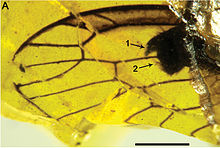ラクダムシ目 (ラクダムシもく、駱駝虫目、Raphidiodea 脈翅上目 (Neuroptera 昆虫 の一群。かつてはヘビトンボ目 とともにアミメカゲロウ目 (Neuroptera [ 3] [ 4] [ 5] ラクダムシ亜目 となる。
完全変態 で肉食性 。体は細長く、幼虫 は成虫 に比べて扁平。幼虫は陸生で、森林の樹皮の隙間などに棲む。ラクダムシという和名は、成虫の頚が長く、中胸が膨れている点がラクダを思わせることによる。ユーラシア周辺、北アフリカ、北アメリカ西部に生息する。
現生種は210種ほど[ 6]
成虫では前胸部が長く伸びるが、前脚は通常の形態で、カマキリモドキ のように変形することはない。口器は強力で、あまり特殊化しない。複眼 は大きく、単眼 を持つ種もいる。雌は長い産卵管 を持ち、木材や腐朽材に産卵する。翅は前後ともほぼ同じ大きさで、翅脈は原始的で縁紋 (英語版 ) [ 7]
幼虫は大きな頭部と突き出した大顎 を持つ。頭部と胸部の第1節は硬化するが、それ以外の部位は柔らかい。脚は3対で腹脚 はないが、腹端には吸着器官がある[ 7]
終齢幼虫は蛹室を作るが、繭は作らない。蛹は幼虫と同じように歩くことができ、羽化前には蛹室を離れることが多い。幼虫から成虫までは2年ほどかかる[ 7]
ヘビトンボ目 ・アミメカゲロウ目 と近縁で、共に脈翅上目 を構成する。脈翅上目自体は鞘翅目 と近縁である。
形態的には、以下の点で他の分類群から区別される[ 8]
前胸部が長く伸びる
眼は突き出し、長い触角と大顎を持つ
翅は2対でほぼ同形
腹部は10節で尾角 はない
産卵管が長く伸びる 現生科はキスジラクダムシ科 Raphidiidae ラクダムシ科 Inocelliidae [ 1]
以下の分類はEngel (2002)・Bechly and Wolf-Schwenninger (2011) ・Ricardo Pérez-de la Fuente et al (2012)などによる[ 1] [ 9] [ 10]
† Priscaenigmatomorpha Engel 2002
Family †Priscaenigmatidae Engel, 2002
Raphidiomorpha
Family †Baissopteridae Martynova , 1961
Family Inocelliidae Navás
Family †Metaraphidiidae Bechly and Wolf-Schwenninger, 2011
Family †Mesoraphidiidae Martynov, 1925 (= Alloraphidiidae, Huaxiaraphidiidae, Sinoraphidiidae, and Jilinoraphidiidae)Amarantoraphidia Subfamily †Alloraphidiinae
Subfamily †Mesoraphidiinae
Genus †Baisoraphidia
Genus †Cretinocellia
Genus †Huaxiaraphidia Hong , 1992 (白亜紀前期; 中国)
Genus †Jilinoraphidia Chang , 1989 (白亜紀前期; 中国)
Genus †Kezuoraphidia
Genus †Mesoraphidia Necroraphidia
Genus †Proraphidia
Genus †Siboptera
Genus †Sinoraphidia
Genus †Xuraphidia Styporaphidia? hispanica
Genus †Yanoraphidia
Tribe †Nanoraphidiini
Genus †Cantabroraphidia
Genus †Grimaldiraphidia
Genus †Nanoraphidia
Genus †Lebanoraphidia
Subfamily †Ororaphidiinae
Subfamily incertae sedis
Genus †Alavaraphidia
Genus †Amarantoraphidia
Genus †Iberoraphidia
Family Raphidiidae Latreille
Family Incertae sedis
^ a b c Engel, M.S. (2002). “The Smallest Snakefly(Raphidioptera: Mesoraphidiidae): A New Species in Cretaceous Amber from Myanmar, with a Catalog of Fossil Snakeflies”. American Museum Novitates 3363 : 1–22. doi :10.1206/0003-0082(2002)363<0001:TSSRMA>2.0.CO;2 . hdl :2246/2852
^ “Raphidiodea in Encyclopedia of life ”. 2013年5月22日 閲覧。 ^ スミソニアン協会 監修(2012)『地球博物学大図鑑』東京書籍 283頁
^ 国立天文台 『理科年表 令和4年』 (2022) 918頁
^ 『岩波生物学辞典 第5版』(2013) pp.1599-1600
^ Jepson, J.E.; Jarzembowski, E.A. (2008). “Two new species of snakefly (Insecta:Raphidioptera) from the Lower Cretaceous of England and Spain with a review of other fossil raphidiopterans from the Jurassic/Cretaceous transition” . Alavesia 2 : 193–201. http://fossilinsects.net/pdfs/Jepson_Jarzembowski_2008_Alavesia_SnakeflyLowerCretaceousEnglandSpain.pdf . ^ a b c Hoell, H.V., Doyen, J.T. & Purcell, A.H. (1998). Introduction to Insect Biology and Diversity, 2nd ed. . Oxford University Press. pp. 445–446. ISBN 0-19-510033-6
^ Gillot, C. (1995). “Raphiodioptera” . Entomology ISBN 978-0-306-44967-3 . https://books.google.co.in/books?id=DrTKxvZq_IcC&lpg=PR1&pg=PA293#v=onepage&q&f=false 14 November 2010 閲覧。 ^ Pérez-de la Fuente, R.; Peñalver, E.; Delclòs, X.; Engel, M.S. (2012). “Snakefly diversity in Early Cretaceous amber from Spain (Neuropterida, Raphidioptera)”. ZooKeys 204 : 1–40. doi :10.3897/zookeys.204.2740 . ^ Bechly, G.; Wolf-Schwenninger, K. (2011). “A new fossil genus and species of snakefly (Raphidioptera: Mesoraphidiidae) from Lower Cretaceous Lebanese amber, with a discussion of snakefly phylogeny and fossil history”. Insect Systematics and Evolution 42 (2): 221–236. doi :10.1163/187631211X568164 .
ウィキメディア・コモンズには、
ラクダムシ亜目 に関連するカテゴリがあります。



